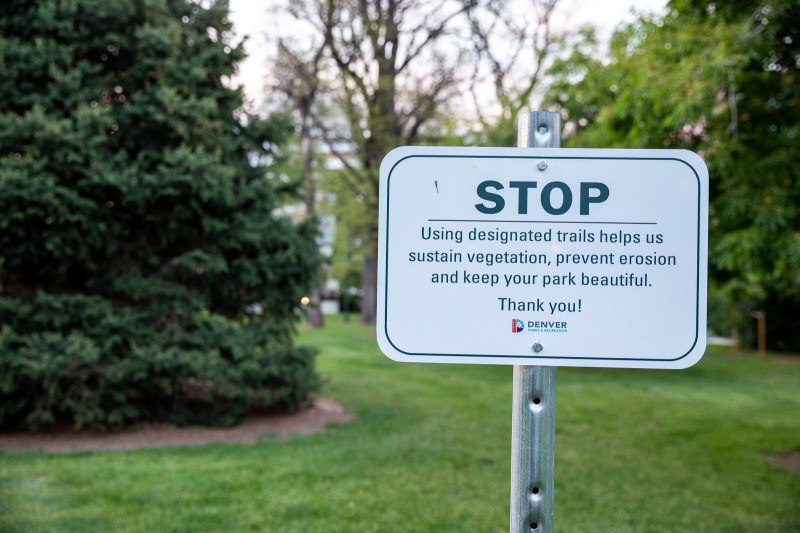Denver Shouts ‘Get Off My Lawn’ With Obnoxious Signs in Cheesman Park

Visitors to Cheesman park are doing it all wrong. A few weeks ago, at least a dozen signs popped up right in the middle of informal trails where people run and walk. They direct people to official paths, reading:
“STOP: Using designated trails helps us sustain vegetation, prevent erosion and keep your park beautiful. Thank you! Denver Parks & Recreation.”
But at least one neighbor thinks the notices, which are attached to signposts planted in concrete, are excessive.
“It’s too much,” said Blake Johnson, who was walking his dog last night. “If you’re running and you’re not looking, it’s dangerous.”

Many people running and walking yesterday evening dodged the signs and their finger-wagging orders. Pedestrian advocates say that such paths show where people want to go and that officials should respond by building formal trails in those locations.
But soon, the informal paths will be wiped out and people will be forced to go around them when Parks & Rec fences them off later this summer. Cyndi Karvaski, a spokesperson for the department, says the effort will make the park more beautiful for parkgoers and keep people from crossing streets where there are no crosswalks.
“Denver Parks and Recreation’s primary concern is for the safety of our visitors and enjoyment of our park system,” she said. “And this enjoyment can be dependent upon the quality of their experience along a trail.”
People shouldn’t pass through the park on their way to somewhere else, either, she says.

“We want people to enjoy the experience of the park,” said Karvaski. “Our parks aren’t thoroughfares to something else.”
But Jill Locantore of WalkDenver says parks should welcome people getting from one place to another, especially considering the city’s goal of reducing the number of people who drive alone in cars.
“Parks & Rec tends to think about walkways for purely recreational purposes,” she said. “I can understand why they discourage vehicular traffic. But why on Earth would they not want people to use the park to get to where they’re trying to go?”
In fact, the city finished building out a master plan for the park in 2008, which called for improving pedestrian access to the surrounding neighborhoods and parkways. “One of the primary goals of this master plan is to create a pedestrian-oriented park,” it reads.
But the admonishing tone from the parks department reflects a failure to listen to people, an increasingly common criticism the city has faced since adopting its Denveright plans for the next 20 years, says Locantore. Informal paths, also known as desire lines, are a way for people to tell the officials what they want without attending public meetings or filling out online surveys, she says.

“I can’t think of a louder comment from people about how they want to access the park,” said Locantore. “Instead of listening to that, officials are scolding people and telling them they’re using the parks the wrong way.”
The parks department could use informal paths to guide where formal paths are laid out, she said, which would address concerns around pedestrian safety by widening existing crosswalks nearby to include the desire paths. Building designated paths in these places would also allow people with mobility challenges, like wheelchair users, to access them.
“When you have these routes that people clearly want to take into the park, you have this situation where you’re discriminating against people who cannot use those social trails,” said Locantore.
She cited the elderly residents of an apartment complex whose path indicated a desire to walk directly from their building’s parking lot into the park. But the Parks Department closed their path last year when it fenced it off.
“Last year on the east side of Cheesman Park, we fenced off the area for approximately a year-and-a-half to restore the grass and ensure people were safely crossing the street,” said Karvaski.
But the closure of their path forced the residents to walk a longer distance to get into the park, said Locantore.
“The whole point of having neighborhood parks is to be able to walk there,” she said. “We should think about our parks as not just places that people go to walk in circles, but as part of the urban fabric that people walk to and through.”
Streetsblog Denver informs the movement for sustainable transportation and a livable city. Give $5 per month.


